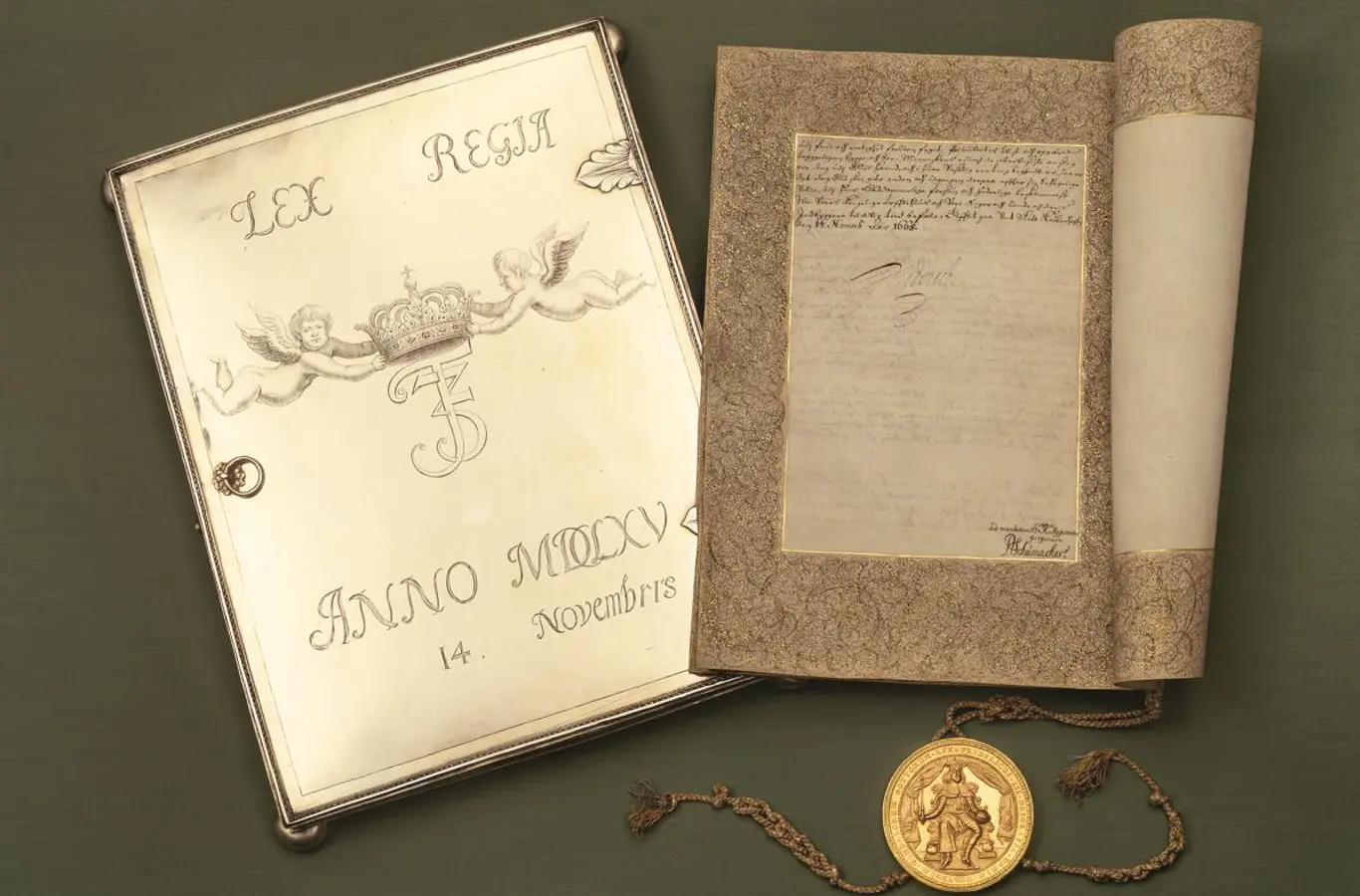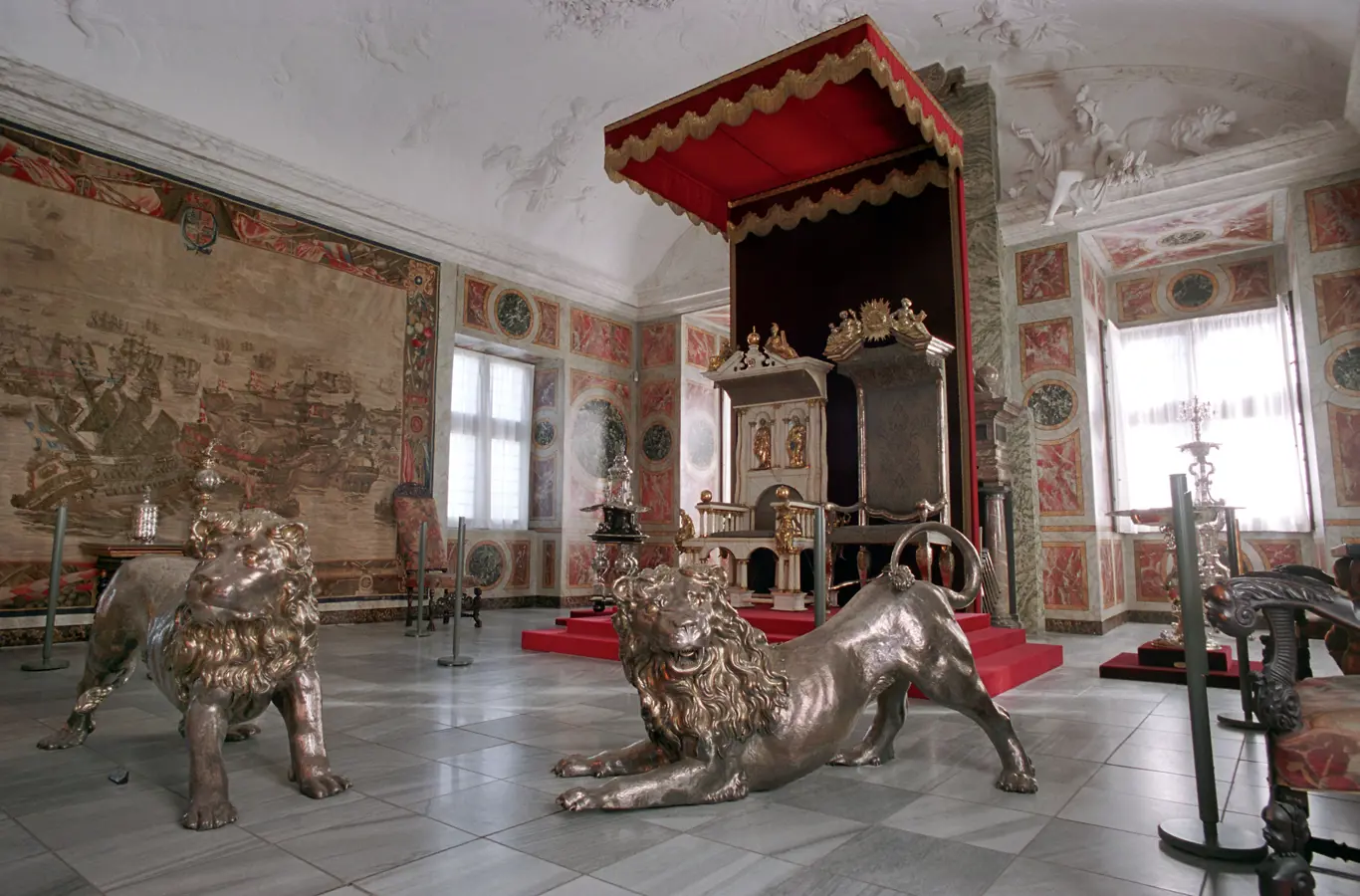
In the royal collections are artefacts that tell the story of the regent as head of state, private person, etc.
In the royal collections are innumerable artefacts that tell the story of the regent as head of state, private person, spouse and parent.
In the collections, the objects that symbolise the royal power and either have been or are still part of the royal ceremonies hold a special status, such as the Lex Regia, the throne, the crown and regalia. A considerable number of these objects were made for the founder of the Danish absolute monarchy, Frederik III.
At Rosenborg Palace are, among other things, a copy of the constitution, Lex Regia, which was the absolute monarchy’s founding document, or constitution. The law, which bears the king’s signature and is dated 14 November 1665, is unique in Europe because it is the only authoritarian constitution set down in writing. This law dictated the three primary duties of the absolute monarch: To worship God and protect the true faith, to hold the kingdom together and to ensure that his power did not deteriorate. In exchange, the king was given unlimited powers and was, according to the constitution, responsible only to God.

Until the introduction of the absolute monarchy in 1660, the king of Denmark was formally elected by the Diet, which literally put the crown on the king’s head and thus showed the power of its members to elect and overthrow the king. When the absolute monarchy was instituted, the nobility lost its influence and its power to appoint the king. Instead, royal power was handed down directly to the oldest son, and the moment the king was dead, the crown prince was the new king. The new king let himself be anointed in a grand religious ceremony, where he put the crown on his head. The anointment symbolised that the king now got his power directly from God, and he was rubbed on the scalp, chest and right wrist with a consecrated oil. The last anointment was of Christian VIII in 1840. Since the Constitution was adopted in 1849, no coronations or anointments have taken place in Denmark. Instead, the prime minister announces the new king from the balcony at Christiansborg.
During the earlier anointments, the king sat in the special anointment throne made of narwhal tusk, which was earlier believed to be unicorn horn. The throne was made for Frederik III by Bendix Grodtschilling. It was first used in 1671 for the anointment of Christian V and last used for Christian VIII’s anointment in 1840. The model for the throne was the biblical King Solomon’s ivory throne. The throne is now placed in the Great Hall at Rosenborg Palace.
The symbols of the king’s power and dignity were the so-called regalia, the crown, the scepter and the orb carried by the king as power symbols during coronation and anointment ceremonies. The ball-shaped or globe-shaped orb is an old power symbol. The Danish orb is a polished golden ball encircled by a diamond-studded, blue-enamelled gold band. The orb was produced in Hamburg for Frederik III’s coronation in 1648. The regalia also includes the sceptre made for Frederik III’s coronation by an unknown Copenhagen goldsmith. The sceptre is made of gold with enamel and table-cut diamonds. Also from Frederik III’s coronation comes the small ointment jar (called a ¨salvebuddike¨), which is made of gold with enamel and table-cut stones. Like the crown, orb and sceptre, the small jar was used for the anointment of absolute monarchs until 1840. Today, the historical artefacts are kept and exhibited in the treasure chamber under Rosenborg Palace.
In the Great Hall of Rosenborg Palace are Frederik III’s three silver lions, which still guard the king’s throne. The lions were made in full scale of 130 kg of embossed silver in 1665-70 by silversmith Ferdinand Kübich in Copenhagen. Like the king’s anointment throne, the lions are inspired by the Old Testament story of king Solomon, whose throne was protected by 12 golden lions. With the silver lions, Frederik III wished to compare himself with the Biblical kings, but only three were finished before his death. Today, the silver lions are used alongside the monarch’s castrum doloris, where the closed coffin is displayed for several days, accessible to the public and guarded by the three lions.

